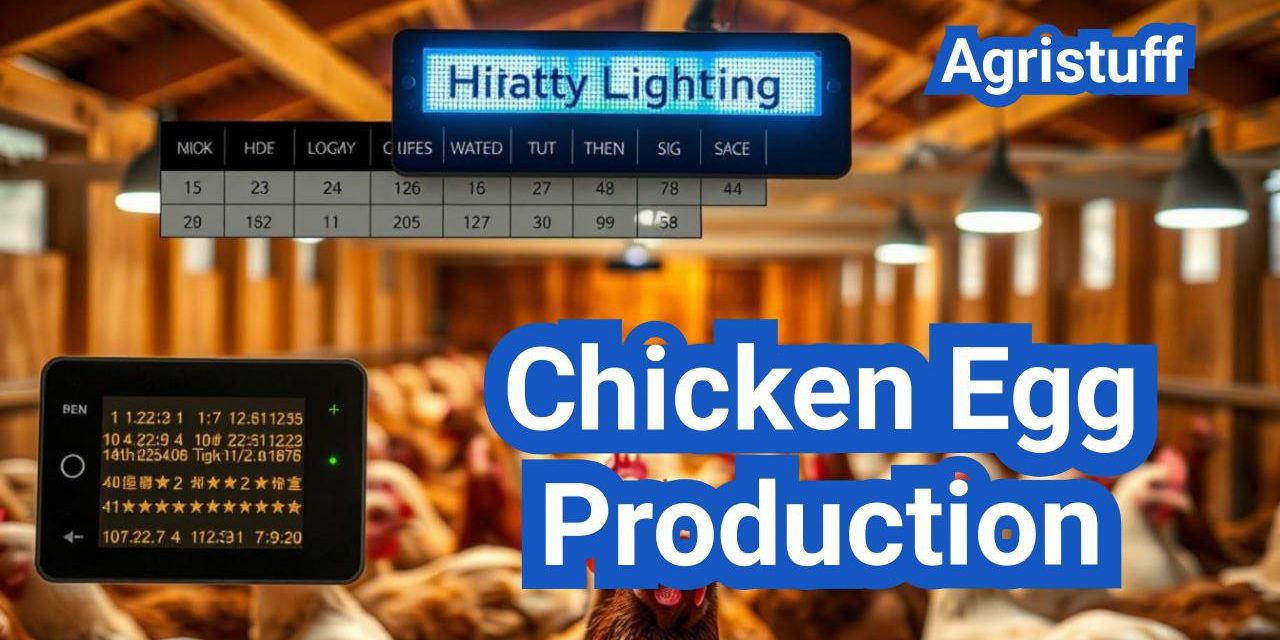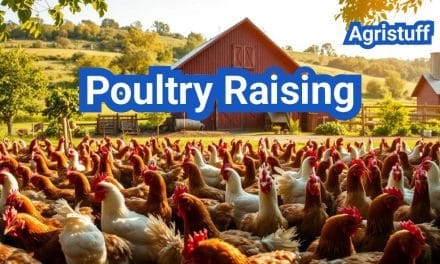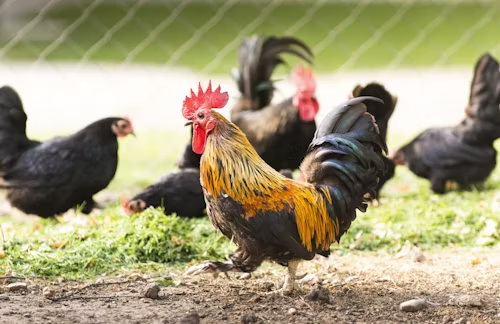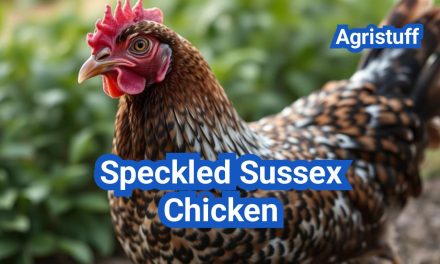Boosting egg laying in chickens ( Chicken egg production ) requires a comprehensive approach that includes managing lighting effectively, optimizing coop conditions, and perfecting the feed formula.
Understanding the chicken egg production cycle is crucial, as it varies by age and breed. Factors such as backyard chicken biosecurity play a significant role in maintaining healthy layers.
A well-planned layer lighting schedule can significantly enhance egg production. By implementing these strategies, farmers and backyard chicken keepers can increase their egg yield.
Key Takeaways
- Effective lighting management is crucial for boosting egg production.
- Optimizing coop conditions enhances layer health and productivity.
- A well-balanced feed formula is essential for maximizing egg laying.
- Understanding the egg production cycle by age and breed is vital.
- Maintaining strong backyard chicken biosecurity measures is key to healthy layers.
Understanding the Chicken Egg Production Cycle
The process of egg formation in chickens is intricate and varies among different breeds and farming conditions. Laying hens follow a specific production cycle that is influenced by factors such as breed characteristics, nutritional intake, and environmental conditions.
The Biological Process of Egg Formation
Egg formation is a complex biological process that involves the coordinated effort of multiple systems within the hen’s body. It begins with the release of yolk from the ovary, which then travels through the oviduct where it is surrounded by albumen (egg white) and membranes, and finally, the shell is formed.
The entire process, from yolk release to egg laying, takes approximately 24-26 hours. Understanding this process is crucial for farmers and backyard chicken keepers to optimize egg production.
Natural Production Patterns and Seasonality
Laying hens naturally follow certain production patterns that can be influenced by seasonality. Most hens will begin laying eggs at around 18-24 weeks of age and will continue to lay for about a year, with the frequency of laying decreasing as they age.
Seasonality can also impact egg production, with many hens reducing or stopping egg production during the winter months due to shorter daylight hours. This natural response can be mitigated with proper lighting.
Factors That Trigger Laying
Several factors can trigger or enhance egg laying in hens, including:
- Nutrition: A balanced diet that includes adequate protein, calcium, and other essential nutrients is crucial for maintaining high egg production.
- Lighting: Providing sufficient light, either naturally or through artificial lighting, can stimulate egg laying.
- Health and Welfare: Ensuring the overall health and welfare of the hens by providing a clean, safe, and stress-free environment can encourage consistent laying.
- Genetics: Different breeds have varying levels of egg production potential, making breed selection an important factor for those looking to maximize egg production.
By understanding and managing these factors, chicken keepers can optimize the egg production cycle of their laying hens.
Chicken Egg Production by Age
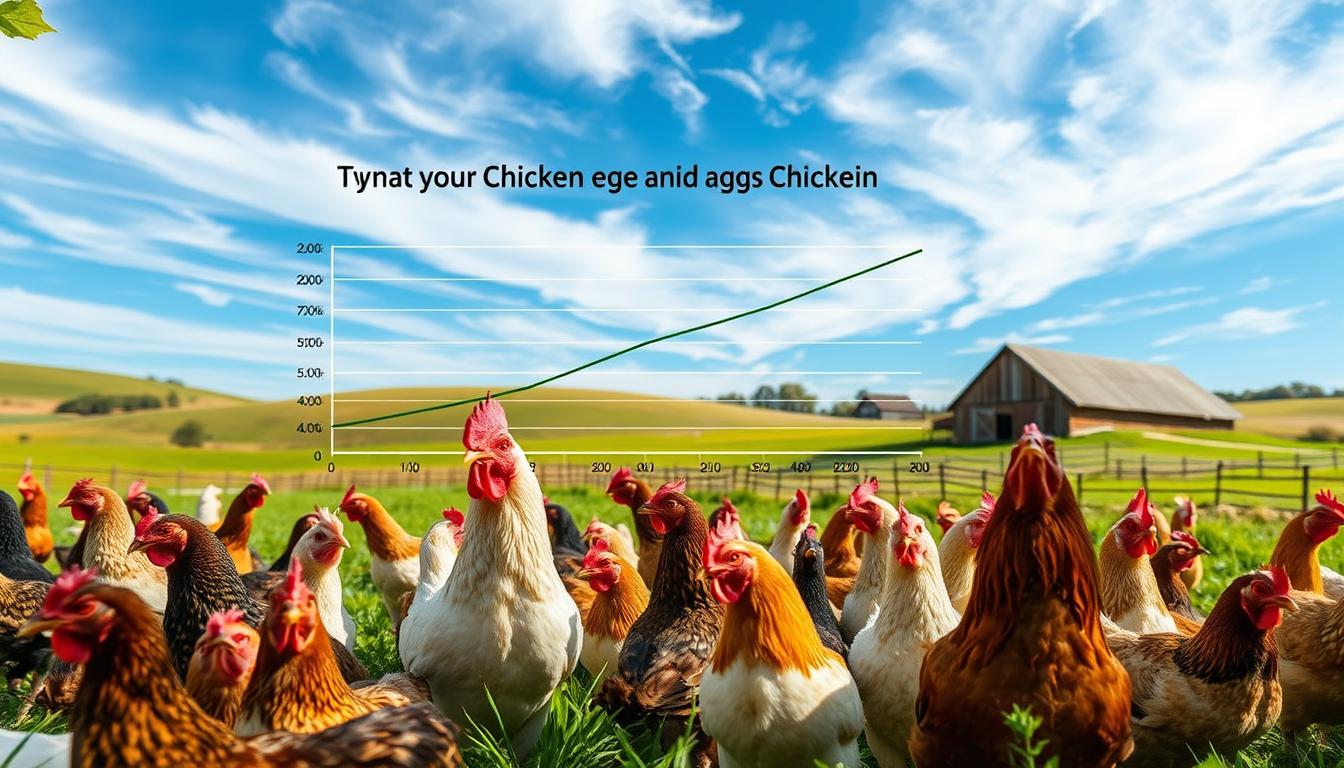
Chicken egg production is a dynamic process that changes as hens mature and age. Understanding these changes is essential for farmers and backyard chicken keepers to optimize egg production.
When Hens Start Laying
Hens typically begin laying eggs at around 18 to 24 weeks of age. This initial phase is crucial as it sets the stage for their future productivity. Factors such as breed, nutrition, and health conditions can influence the onset of laying.
Peak Production Periods | Chicken egg production
After starting to lay, hens usually reach their peak production within the first year. During this period, they can lay almost one egg per day, depending on the breed and management practices. Proper nutrition and a stress-free environment are key to maintaining high production levels.
Age-Related Decline in Production | Chicken egg production
As hens age, their egg production gradually declines. This decline is a natural process, but it can be influenced by factors such as health, nutrition, and management practices. Understanding and managing these factors can help extend the productive life of laying hens.
By recognizing the different stages of egg production and how they are affected by age, farmers and chicken keepers can implement strategies to maximize output and maintain the health and well-being of their hens.
Measuring Chicken Egg Production Rates
Understanding how to measure chicken egg production rates is crucial for farmers and backyard chicken keepers alike. Accurate measurement helps in identifying areas of improvement, optimizing feed and management practices, and ultimately increasing profitability.
Average Production Per Day | Chicken egg production
The average egg production per day is a fundamental metric that varies depending on the breed and management practices. For instance, commercial layers like Leghorns can produce around 280-300 eggs per year, translating to approximately 0.8 eggs per day. Efficient management practices can significantly impact this rate.
Expected Production Per Year | Chicken egg production
Expected production per year is another critical measure. Most commercial egg-laying breeds are expected to produce between 280 to 320 eggs per year. Factors such as nutrition, lighting, and health play a significant role in achieving these production levels.
Hen-Day Egg Production Calculations
Hen-day egg production is a more nuanced metric that calculates the average number of eggs produced per hen per day over a specific period. It’s a valuable tool for assessing the productivity of a flock. The formula involves dividing the total number of eggs produced by the number of hen-days (the sum of the number of hens alive each day during the period).
- Total eggs produced in a week: 700
- Total hen-days in a week: 1000
- Hen-day egg production: 700 / 1000 = 0.7 or 70%
Using Chicken Egg Production Charts
Chicken egg production charts are visual tools that help farmers track and predict egg production. These charts can be based on historical data and breed standards. By comparing actual production against expected production, farmers can identify issues early.
For example, a production chart might show that a flock is underperforming during a certain period, prompting the farmer to investigate potential causes such as feed quality, health issues, or environmental factors.
Top Breeds for Optimal Chicken Egg Production

The productivity of your backyard or commercial flock largely depends on choosing breeds known for high egg production. With numerous breeds available, each with its unique characteristics, selecting the right one can significantly impact your egg yield.
Commercial Egg-Laying Breeds
Commercial egg-laying breeds are specifically bred for their high egg production capabilities. Breeds like the Isa Brown and Hy-Line Brown are renowned for their productivity, laying a high volume of eggs consistently. These breeds are often used in large-scale commercial egg production due to their efficiency and reliability.
Heritage Breeds with High Production | Chicken egg production
While commercial breeds lead in egg production, certain heritage breeds also offer impressive laying capabilities. Breeds such as the Leghorn and Rhode Island Red are not only valued for their historical significance but also for their ability to produce a substantial number of eggs. These breeds can be an excellent choice for backyard flocks where both heritage and productivity are desired.
Specialty Egg Layers
For those interested in unique egg colors or sizes, specialty egg layers offer a fascinating alternative. Breeds like the Araucana, known for laying blue eggs, or the Marans, which produce dark chocolate-brown eggs, can add diversity to your egg basket. While their production rates might not match those of commercial breeds, they bring a unique appeal to backyard flocks.
Understanding the characteristics of different breeds can help you make informed decisions about which hens to include in your flock. Whether you’re aiming for maximum production or seeking to diversify your egg collection, there’s a breed suited to your needs.
Nutrition Fundamentals for Laying Hens
Nutrition plays a vital role in the health and productivity of laying hens. A well-balanced diet is essential for maintaining high egg production and ensuring the overall well-being of the hens.
Essential Nutrients for Egg Production
Laying hens require a diet rich in essential nutrients to support egg production. These nutrients include proteins, carbohydrates, vitamins, and minerals. Adequate nutrition is critical for maintaining the health of the hens and the quality of the eggs.
Protein Requirements for Laying Hens
Protein is a crucial component of a laying hen’s diet, as it is necessary for the production of eggs. The protein requirement for laying hens typically ranges between 16% and 18% of the total diet. High-quality protein sources are essential for optimal egg production.
Calcium Supplementation for Strong Shells | Chicken egg production
Calcium is vital for laying hens, particularly for the production of strong eggshells. A deficiency in calcium can lead to weak or thin shells. Calcium supplementation is often necessary to ensure that laying hens receive adequate amounts. It is recommended to provide a separate source of calcium, such as crushed oyster shells or limestone, to support eggshell quality.
Laying hens require a diet rich in calcium to produce strong eggshells. Ensuring adequate calcium intake is crucial for maintaining egg quality and reducing the incidence of shell breakage.
Optimizing Feed Management for Maximum Production

To achieve maximum egg production, it’s essential to optimize feed management strategies. Effective feed management involves several key factors that contribute to the overall health and productivity of laying hens.
Types of Commercial Layer Feeds | Chicken egg production
Commercial layer feeds are formulated to meet the nutritional needs of laying hens. These feeds typically come in different formulations based on the age and production level of the hens. For instance, starter feeds are for young hens, while layer feeds are for hens in production. Choosing the right type of feed is crucial for maximizing egg production.
Layer feeds are usually categorized into different phases, such as starter, grower, and layer phases. Each phase is designed to meet the specific nutritional requirements of the hens at different stages of their lives. Understanding these nutritional needs is vital for selecting the appropriate feed.
Feed Consumption Rates | Chicken egg production
Monitoring feed consumption rates is essential to ensure that hens are receiving the necessary nutrients for optimal egg production. Factors such as feed quality, environmental conditions, and the health of the hens can influence feed consumption rates.
- Average feed consumption per hen per day
- Factors affecting feed consumption
- Adjusting feed consumption rates based on production levels
Feeder Design and Placement | Chicken egg production
The design and placement of feeders can significantly impact feed consumption and, consequently, egg production. Feeders should be designed to minimize waste and ensure easy access for the hens.
Proper feeder placement can help reduce stress among hens and promote healthy feeding behavior. It’s also important to ensure that feeders are kept clean and free from contamination.
Water Quality and Availability | Chicken egg production
Access to clean water is crucial for maintaining high egg production. Water quality can significantly impact the health and productivity of laying hens. Ensuring that water is free from contaminants and available at all times is essential.
Regularly checking water quality and ensuring that watering systems are clean and functioning properly can help prevent health issues and maintain optimal egg production.
The Impact of Light on Chicken Egg Production

Understanding the impact of light on chicken egg production is essential for maximizing laying performance. Lighting plays a crucial role in regulating the reproductive cycle of hens, influencing their overall health and productivity.
Natural vs. Artificial Lighting for Chicken egg production
Chickens can be exposed to both natural and artificial lighting. While natural light is ideal, many commercial egg production facilities rely on artificial lighting to control the lighting schedule. Artificial lighting can supplement natural light to ensure a consistent day length, which is critical for maintaining high egg production levels.
The choice between natural and artificial lighting depends on the production system. For instance, free-range systems often rely on natural light, while confined systems may use artificial lighting to control the environment.
Optimal Layer Lighting Schedules for Chicken egg production
A well-designed lighting schedule is vital for optimizing egg production. Research indicates that 14-16 hours of light per day is optimal for laying hens. This duration stimulates the hens’ reproductive system, encouraging consistent laying.
- Gradually increase light hours to the optimal range to avoid stressing the birds.
- Maintain a consistent lighting schedule to support the hens’ biological rhythms.
- Consider using a layer lighting schedule that mimics natural daylight patterns.
Light Intensity and Spectrum Considerations
Not only the duration but also the intensity and spectrum of light affect egg production. Light intensity should be sufficient to stimulate activity without causing stress. Typically, a light intensity of 10-20 lux is recommended for laying hens.
The spectrum of light can also influence the birds’ behavior and physiology. While chickens are most sensitive to the red and blue spectrum, using LED lights with a specific spectrum can enhance egg production.
Seasonal Lighting Adjustments for Chicken egg production
In regions with significant seasonal changes in daylight hours, adjustments to the lighting schedule may be necessary. Supplementing natural light during shorter winter days can help maintain egg production. Conversely, during longer summer days, the lighting schedule may need to be adjusted to prevent over-stimulation.
- Monitor daylight hours and adjust artificial lighting accordingly.
- Use timers to automate lighting adjustments and maintain consistency.
- Consider the age and breed of the hens when determining the lighting schedule.
Creating the Ideal Laying Environment

Creating an ideal laying environment is essential for the health and productivity of hens. A well-designed poultry house environment can significantly impact egg production rates and the overall well-being of the flock.
Temperature and Ventilation Control for Chicken egg production
Maintaining optimal temperature and ventilation is critical in a poultry house. Proper ventilation helps in removing moisture, reducing ammonia levels, and regulating temperature. The ideal temperature range for laying hens is between 65°F to 75°F (18°C to 24°C).
Adequate ventilation also plays a crucial role in reducing stress among hens, which in turn can improve egg production. Ventilation systems should be designed to provide a consistent flow of fresh air throughout the poultry house.
| Temperature (°F) | Impact on Hens | Recommended Action |
|---|---|---|
| Below 65 | Reduced activity, potential cold stress | Increase heating or insulation |
| 65-75 | Optimal comfort, high productivity | Maintain current conditions |
| Above 75 | Heat stress, reduced egg production | Enhance ventilation, provide cooling |
Managing Poultry Heat Stress for Chicken egg production
Heat stress is a significant concern in poultry production, particularly during warmer months. Strategies to manage heat stress include providing adequate ventilation, ensuring access to cool water, and using cooling systems such as misting or fogging.
Reducing Ammonia in Poultry Houses for Chicken egg production
High levels of ammonia can be detrimental to the health of laying hens. Reducing ammonia involves proper manure management, adequate ventilation, and regular cleaning of the poultry house. Ammonia levels should be kept below 20 ppm (parts per million).
Space Requirements for Laying Hens for Chicken egg production
Adequate space is essential for the welfare of laying hens. Providing sufficient space can help reduce stress and improve egg production. The recommended space per hen varies but generally falls within 2-4 square feet per bird inside the poultry house.
By focusing on these key aspects, poultry farmers can create an ideal laying environment that promotes the health, welfare, and productivity of their hens.
Nest Box Management for Increased Laying

Nest box management plays a vital role in the overall productivity of a laying hen operation. By optimizing nest box design, placement, and maintenance, farmers can encourage hens to lay eggs in the desired location, reducing the incidence of floor eggs and improving overall egg production.
Optimal Nest Box Design for Chicken egg production
The design of the nest box is critical for encouraging hens to lay eggs inside them. A well-designed nest box should be comfortable, safe, and appealing to the hens. Key considerations include the size of the nest box, the material it’s made of, and the ease of access for both hens and farmers.
Key Features of Optimal Nest Box Design:
- Appropriate size to accommodate the breed and size of the hen
- Soft, dry bedding material
- Easy access for hens and simple cleaning for farmers
- Protection from predators and drafts
Nest Box Ratios and Placement for Chicken egg production
The ratio of nest boxes to hens and their placement within the poultry house are crucial factors in nest box management. A general rule of thumb is to provide one nest box for every 4 to 5 hens. The placement of nest boxes in quiet, secure locations can encourage hens to use them.
| Nest Box Ratio | Expected Outcome |
|---|---|
| 1:4 to 1:5 | Optimal egg laying in nest boxes |
| 1:6 or more | Increased risk of floor eggs |
Keeping Nests Clean and Appealing for Chicken egg production
Maintaining clean and appealing nest boxes is essential for encouraging hens to lay eggs in them. Regular cleaning and replacement of bedding material can help keep the nest boxes free from disease and parasites.
Preventing Floor Eggs
Floor eggs can be a significant problem in poultry operations, leading to losses in egg production and increased cleaning costs. Strategies for preventing floor eggs include ensuring adequate nest box provision, maintaining cleanliness, and reducing stress among the hens.
Strategies to Prevent Floor Eggs:
- Ensure sufficient nest box availability
- Maintain a clean and comfortable environment
- Minimize stress through proper handling and environmental control
Backyard Chicken Biosecurity Measures

Backyard chicken keepers must prioritize biosecurity to prevent disease outbreaks and ensure the well-being of their flock. Biosecurity refers to the practices and measures taken to prevent the introduction and spread of diseases within the flock.
Disease Prevention Strategies for Chicken egg production
Disease prevention is a critical component of backyard chicken biosecurity. This includes maintaining a clean environment, providing vaccinations, and monitoring the health of the flock regularly. Regular cleaning and disinfection of the coop and equipment are essential to prevent the buildup of pathogens.
Implementing a strict biosecurity protocol can significantly reduce the risk of disease introduction and spread. This includes controlling access to the flock, using foot baths, and ensuring that all equipment is properly disinfected.
| Disease Prevention Measure | Description | Frequency |
|---|---|---|
| Coop Cleaning | Remove soiled bedding, clean surfaces, and disinfect | Weekly |
| Vaccination | Administer vaccinations as recommended by a veterinarian | As scheduled |
| Flock Monitoring | Observe chickens for signs of illness or stress | Daily |
Visitor and Equipment Protocols for Chicken egg production
Controlling who and what comes into contact with the flock is vital. Limiting visitor access and ensuring that any equipment brought into the coop area is properly cleaned and disinfected can prevent the introduction of diseases.
For equipment, using a dedicated set for the coop and avoiding sharing with other flocks or farms can minimize the risk of disease transmission.
Quarantine Procedures for New Birds for Chicken egg production
Introducing new birds to the flock requires careful planning. Quarantining new birds for at least 30 days before integrating them with the existing flock can prevent the introduction of diseases.
During quarantine, monitor the new birds for any signs of illness and ensure they are healthy before introducing them to the rest of the flock.
Vaccination Programs for Layers
Vaccinations play a crucial role in preventing diseases among laying hens. Consulting with a veterinarian to develop a vaccination program tailored to the specific needs of the flock is essential.
Vaccination programs can protect against common diseases and help maintain the overall health and productivity of the flock.
Parasite Control for Healthy Layers

Parasites can significantly impact the health and productivity of laying hens, making control measures essential. Effective parasite control is crucial for maintaining a healthy flock and ensuring optimal egg production.
Common External Parasites for Chicken egg production
External parasites such as mites, lice, and fleas can cause discomfort, stress, and disease in chickens. Mites are particularly problematic as they can lead to anemia and decreased egg production. Regular inspections and monitoring are key to detecting these parasites early.
Internal Parasite Management for Chicken egg production
Internal parasites, including worms, pose a significant threat to the health of laying hens. Roundworms and tapeworms are common internal parasites that can cause weight loss, reduced egg production, and increased susceptibility to disease. Implementing a regular deworming program is vital.
Natural and Chemical Treatment Options
There are various treatment options available for controlling parasites in chickens. Chemical treatments, such as pesticides and deworming medications, are effective but must be used judiciously to avoid resistance. Natural alternatives, including diatomaceous earth and certain herbal remedies, offer a more organic approach to parasite control.
It’s essential to rotate between different treatment options to prevent the development of resistance. Additionally, maintaining a clean and dry living environment for the chickens can significantly reduce the risk of parasite infestations.
Troubleshooting Decreased Chicken Egg Production

Understanding the reasons behind a decline in chicken egg production is key to addressing the issue. Various factors can influence a hen’s ability to lay eggs, and identifying these factors is crucial for restoring optimal production.
Common Causes of Production Decline for Chicken egg production
A decline in egg production can be attributed to several common causes. Nutritional deficiencies play a significant role, as a diet lacking essential nutrients can directly impact a hen’s laying ability. Ensuring that hens receive a balanced diet that includes adequate protein, calcium, and other vital nutrients is crucial.
Another factor is the age of the hens. As hens get older, their egg production naturally decreases. While this decline is inevitable, understanding the peak production periods and managing the flock’s age structure can help maintain overall production levels.
Stress Factors and Their Management for Chicken egg production
Stress is a significant factor that can lead to decreased egg production. Environmental stressors such as extreme temperatures, inadequate ventilation, and overcrowding can all contribute to stress in hens. Managing these factors by ensuring a comfortable and well-ventilated living environment can help mitigate stress.
Social stress within the flock is another consideration. Introducing new hens to the flock or having a dominant hen can cause stress among the other hens, potentially leading to a decline in egg production. Strategies such as gradual introductions and providing enough space can help reduce social stress.
Health Issues That Affect Laying for Chicken egg production
Health issues are a direct and significant cause of decreased egg production. Diseases and parasites can severely impact a hen’s health and ability to lay eggs. Regular health checks, vaccinations, and parasite control measures are essential for maintaining the health of the flock.
Reproductive health issues can also affect egg production. Conditions such as egg binding or reproductive tract infections can cause pain and reduce laying. Monitoring the health of the hens and seeking veterinary advice when necessary is crucial.
Seasonal Challenges and Solutions for Chicken egg production
Seasonal changes can influence egg production, with daylight hours being a critical factor. Hens typically lay more eggs during periods with longer daylight hours. Using artificial lighting can help maintain production levels during shorter days.
Extreme weather conditions, such as very hot or cold temperatures, can also impact egg production. Providing adequate shelter, ensuring proper ventilation, and managing the temperature within the coop can help mitigate these effects.
Improving Egg Shell Quality
Maintaining strong eggshells is essential for preventing breakage and ensuring the overall quality of eggs produced. Several factors contribute to eggshell quality, including nutrition, environmental conditions, and the age of the hens.
Nutritional Factors Affecting Shell Strength
Nutrition plays a crucial role in determining eggshell quality. Calcium intake is particularly important as it is a key component of eggshells. Hens require a diet rich in calcium to produce strong eggshells.
A balanced layer feed that includes adequate calcium and other essential nutrients is vital. The table below outlines the recommended nutritional levels for laying hens.
| Nutrient | Recommended Level |
|---|---|
| Calcium | 3.5-4% |
| Phosphorus | 0.35-0.45% |
| Vitamin D3 | 2,000-3,000 IU/kg |
Environmental Impacts on Shell Quality
Environmental factors, such as temperature and humidity, can significantly impact eggshell quality. High temperatures, for instance, can lead to stress in hens, resulting in weaker eggshells.
Ensuring a comfortable and stress-free environment for laying hens is crucial for maintaining strong eggshells.
Age-Related Shell Issues for Chicken egg production
As hens age, their ability to produce strong eggshells can decline. Older hens may require additional nutritional support to maintain eggshell quality.
Addressing Thin or Soft Shells for Chicken egg production
Thin or soft shells can be a significant issue for egg producers. Strategies to address this include adjusting the diet to ensure adequate calcium intake and managing environmental stressors.
By understanding and addressing the factors that influence eggshell quality, producers can improve the strength and durability of their eggs, enhancing overall production quality.
Free-Range vs. Confined Production Systems
Understanding the differences between free-range and confined production systems is crucial for optimizing chicken egg production and ensuring the health of laying hens. The choice between these two systems significantly impacts not only the welfare of the hens but also the quality and quantity of the eggs produced.
Production Differences Between Systems
Free-range systems allow hens to roam outdoors, which can lead to variations in egg production due to factors like foraging opportunities and exposure to natural elements. In contrast, confined production systems keep hens in controlled environments, which can result in more consistent egg production rates.
“Free-range hens often produce eggs with deeper yolks and richer flavor due to their diverse diet,” notes a study on poultry production. This difference highlights the potential nutritional benefits of free-range systems.
Nutritional Benefits of Free-Range
Free-range chicken eggs are often considered more nutritious due to the hens’ access to a varied diet that includes insects, plants, and other foraging materials. These eggs tend to have higher levels of omega-3 fatty acids and vitamins A and E.
- Higher omega-3 fatty acids
- Increased vitamins A and E
- Better fatty acid profile
Managing Predator Risks
One of the significant challenges of free-range systems is managing predator risks. Hens are vulnerable to predators like foxes, hawks, and raccoons when they are outdoors. Implementing protective measures such as secure fencing, guard animals, and covered runs can help mitigate these risks.
Effective predator management strategies include:
- Using robust fencing that extends below ground to prevent burrowing
- Employing guard animals like dogs or donkeys
- Covering outdoor runs to protect from aerial predators
Balancing Freedom and Protection for Chicken egg production
Balancing the freedom of hens to roam with the need to protect them from predators is a key challenge in free-range systems. Providing hens with safe outdoor access while minimizing risks requires careful planning and management.
“The key to successful free-range egg production lies in striking a balance between giving hens the freedom to express their natural behaviors and protecting them from the dangers that come with it.” – Poultry Expert
By understanding the production differences, nutritional benefits, and challenges associated with free-range and confined production systems, producers can make informed decisions that optimize egg production while ensuring the welfare of their hens.
Breeding Strategies for Enhanced Egg Production
To maximize egg production, farmers must implement well-planned breeding strategies. Breeding programs that focus on genetic diversity can lead to healthier and more productive flocks.
Selecting for Productive Traits for Chicken egg production
Selecting hens with desirable egg production traits is crucial for a successful breeding program. Traits such as high egg production rate, strong eggshell quality, and disease resistance should be prioritized. By focusing on these characteristics, farmers can improve the overall productivity of their flock.
Key Traits to Select For:
- High egg production rate
- Strong eggshell quality
- Disease resistance
- Good temperament
Crossbreeding for Hybrid Vigor for Chicken egg production
Crossbreeding is a technique used to achieve hybrid vigor, resulting in offspring that are more productive and resilient than their parents. This method involves breeding two different pure lines to produce hybrid hens that lay more eggs.
Benefits of Crossbreeding:
- Increased egg production
- Improved disease resistance
- Better adaptation to different environments
Maintaining Genetic Diversity for Chicken egg production
Maintaining genetic diversity within a flock is essential for long-term success. Genetic diversity helps to ensure that the flock remains healthy and adaptable to changing conditions. Breeding programs should aim to preserve a wide range of genetic traits.
| Benefits of Genetic Diversity | Description |
|---|---|
| Improved Health | Reduced susceptibility to diseases |
| Adaptability | Better adaptation to environmental changes |
| Productivity | Enhanced egg production and quality |
Commercial vs. Backyard Breeding Goals for Chicken egg production
Breeding goals can vary significantly between commercial and backyard producers. Commercial producers often focus on maximizing egg production and efficiency, while backyard producers may prioritize traits such as temperament and foraging ability.
Understanding these different goals is crucial for developing effective breeding strategies. By selecting the right breeding approach, farmers can achieve their production objectives while maintaining a healthy and productive flock.
Sustainable Practices for Long-Term Success
Implementing sustainable poultry practices is crucial for achieving long-term success in egg production. By understanding the chicken egg production cycle, nutrition fundamentals, and optimal laying environments, producers can maximize their yields while minimizing environmental impact.
Sustainable practices such as optimizing feed management, maintaining biosecurity measures, and controlling parasites contribute to the overall health and productivity of laying hens. Additionally, strategies like breeding for productive traits and managing lighting schedules can further enhance egg production.
By adopting these strategies and focusing on sustainable poultry practices, egg producers can ensure a profitable and environmentally friendly operation. Long-term success in the egg production industry relies on balancing productivity with sustainability, ultimately benefiting both the producer and the consumer.
FAQ
What is the chicken egg production cycle?
The chicken egg production cycle refers to the process by which hens produce eggs, influenced by factors such as age, nutrition, and light exposure.
How do chickens make eggs?
Chickens produce eggs through a complex biological process involving the release of yolks, formation of egg whites, and shell creation, taking around 24-26 hours.
What affects egg laying in chickens?
Egg laying in chickens is affected by factors such as nutrition, light exposure, age, breed, and health status.
When do chickens start laying eggs?
Chickens typically start laying eggs between 18-24 weeks of age, depending on breed and nutrition.
How many eggs do chickens lay per year?
The average number of eggs laid per year varies by breed, with commercial layers producing around 300-320 eggs per year.
What are the best egg-laying chicken breeds?
Popular egg-laying breeds include Leghorns, Isa Browns, and Hy-Line Browns, known for their high production rates.
How can I improve egg shell quality?
Improving egg shell quality involves providing adequate calcium supplementation, maintaining optimal environmental conditions, and ensuring proper nutrition.
What is the importance of light in egg production?
Light exposure plays a crucial role in regulating egg production, with hens requiring a certain amount of daylight or artificial lighting to maintain laying.
How can I manage poultry heat stress?
Managing poultry heat stress involves providing adequate ventilation, cooling systems, and ensuring access to cool water and shade.
What are the benefits of free-range egg production?
Free-range egg production offers nutritional benefits, improved animal welfare, and potentially better egg quality, but requires careful management of predator risks.
How can I prevent diseases in my backyard chickens?
Preventing diseases in backyard chickens involves implementing biosecurity measures, vaccination programs, and maintaining a clean environment.
What are the common causes of decreased egg production?
Decreased egg production can be caused by factors such as stress, health issues, nutritional deficiencies, and seasonal changes.
How can I optimize feed management for egg production?
Optimizing feed management involves providing a balanced diet, ensuring adequate protein and calcium, and managing feed consumption rates.
What are the key factors in breeding chickens for egg production?
Breeding chickens for egg production involves selecting for productive traits, maintaining genetic diversity, and considering commercial or backyard breeding goals.
Conclusion of: Chicken Egg Production
Chicken Egg Production improves when you align the big levers—genetics, nutrition, lighting, housing, health, and daily habits—into one consistent plan. This USA‑focused guide translates research and extension best practices into step‑by‑step actions you can apply in backyard or small farm settings to lift lay rates, stabilize shell quality, and reduce losses. Use it as a ready checklist to make measurable gains in Chicken Egg Production while keeping bird welfare and food safety front and center. Small‑Scale Egg Production – Penn State Extension
Choose Genetics That Fit Your Goals
Your starting point for higher Chicken Egg Production is breed and strain selection. Modern layer hybrids (e.g., white‑egg Leghorn strains, brown‑egg sex‑links) tend to out-lay heritage breeds, but matching strain to climate and housing is equally important. Review breed/strain guides, expected egg numbers, and body size so feed conversion stays efficient. For pasture or mixed systems, choose productive but hardy lines and plan a staggered flock to avoid seasonal gaps in Chicken Egg Production. Pastured Poultry for Small Farms – NC State Extension (PDF)
Raise Pullets Right: Photoperiod From Day One
To protect Chicken Egg Production at first lay, manage daylength during rearing so it never decreases as birds mature. Keep a steady schedule, then step pullets up to 14–16 total hours as they near onset of lay. A smooth transition prevents premature molt and supports a strong peak in Chicken Egg Production. Use reliable timers and avoid abrupt lighting changes, especially during the 16–20 week window. Lighting for Small & Backyard Flocks – UF/IFAS
Lock In Light for Layers (14–16 Hours Daily)
Once laying starts, stabilize Chicken Egg Production year‑round with 14–16 hours of light. Add morning light so “sunrise” never gets later, and position bulbs to brightly illuminate feeders while keeping nest boxes dim. Check intensity and coverage, replace burned‑out bulbs promptly, and document your photoperiod in a calendar to correlate with trends in Chicken Egg Production. Lighting for Small & Backyard Flocks – UF/IFAS
Feed a Complete Layer Ration—Don’t Dilute It
A balanced layer ration underpins dependable Chicken Egg Production. Avoid diluting the diet with scratch grains or leftovers that throw off energy, amino acids, vitamins, and minerals. Use fresh feed, store it dry and cool, and follow the tag for protein and lysine levels. Consistent intake of a complete ration supports uniform yolk color, albumen quality, and steady Chicken Egg Production. Feeding the Laying Hen – Alabama Extension
Offer Free‑Choice Calcium to Strengthen Shells
Thin or soft shells signal a risk to Chicken Egg Production value. Keep a separate container of oyster shell so hens can self‑regulate calcium on top of their complete feed, and ensure adequate vitamin D3. Review shell texture and breakage weekly; correcting mineral balance often restores both shell quality and overall Chicken Egg Production. Mineral Deficiencies & Eggshell Quality – Merck Veterinary Manual
Prioritize Water: Clean, Cool, and Continuous
Water drives feed intake and, ultimately, Chicken Egg Production. Hens commonly drink roughly twice as much water as feed by weight; intake rises sharply in heat. Keep lines or buckets clean, prevent freezing, and add extra drinkers during hot spells. Record daily checks so you can trace any dip in Chicken Egg Production back to interruptions in water availability. How Much Water Do Chickens Need? – OSU Extension
Give Adequate Space, Dry Litter, and Good Perches
Comfortable housing keeps birds eating and laying, sustaining Chicken Egg Production. Target at least 1.5 ft² per hen indoors, maintain 3–4 inches of dry, absorbent litter, and provide sturdy perches. Manage stocking density as birds grow; crowding increases aggression and reduces time at the feeder, eroding Chicken Egg Production. Management Requirements for Laying Flocks – Penn State Extension
Keep Air Fresh: Ventilation and Ammonia Control
Stale air and ammonia stress birds and can suppress Chicken Egg Production. Keep winter ventilation running to remove moisture, check litter for wet spots under drinkers, and use simple test kits to monitor ammonia. Aim to stay well below ~25 ppm to protect respiratory health and maintain strong Chicken Egg Production. Detecting Ammonia in Poultry Housing – Penn State Extension
Provide Enough Nests (and Keep Them Inviting)
Floor eggs damage quality and waste labor in Chicken Egg Production. Offer about one nest per 4–5 hens, sized near 12″×12″ with soft bedding and low light. Collect eggs at least twice daily and refresh bedding to keep nests attractive. Good nest design and diligent collection preserve shell integrity and the value of your Chicken Egg Production. Nest Box Guidelines – Penn State Extension
Manage Heat: Shade, Airflow, and Cool Water
Heat stress cuts feed intake, thins shells, and lowers Chicken Egg Production. Add shade, improve air movement with fans, and provide cool water. Avoid handling birds during peak heat and consider electrolytes per extension advice. Proactive cooling during hot months helps maintain consistent Chicken Egg Production. Preventing Heat Stress – University of Minnesota Extension
Support Winter Lay With Smart Lighting
Short days can reduce Chicken Egg Production, but careful light scheduling offsets seasonal dips. Maintain 14–16 total hours with timers and add light before dawn so birds wake to feed. Keep intensity consistent through winter and avoid sudden changes that could interrupt Chicken Egg Production. Lighting for Layers – UF/IFAS
Stay Ahead of External Parasites (Mites & Lice)
Unchecked parasites sap energy and can drop Chicken Egg Production by notable margins. Inspect vents and under wings weekly, clean cracks and perches, and treat promptly according to label and extension guidance. Keep wild birds and rodents out to break reinfestation cycles and protect Chicken Egg Production. Northern Fowl Mite – UF/IFAS EDIS
Practice Daily Biosecurity
Strong biosecurity shields Chicken Egg Production from disease setbacks. Use dedicated boots and clothing, control visitor access, separate species, and disinfect tools. Post a simple entry checklist by the coop door; small habits prevent big losses and keep Chicken Egg Production on track. USDA APHIS – Defend the Flock Resources
Collect, Clean & Chill Eggs the Right Way
Good handling preserves the value of your Chicken Egg Production. Collect eggs often, avoid washing warm eggs with cold water, and refrigerate promptly to slow bacterial growth. Educate family and customers on safe storage and cooking to firm yolks and whites. Consistent hygiene protects both reputation and Chicken Egg Production. CDC – Backyard Poultry & Salmonella Safety
Know U.S. Refrigeration Rules if You Scale Up
As Chicken Egg Production reaches commercial scale, U.S. law requires careful temperature control. The FDA Egg Safety Rule sets refrigeration at ≤45°F no later than 36 hours after lay for covered farms. Even for small flocks, chilling to ≤40°F protects quality in transport and sale, supporting dependable Chicken Egg Production. FDA Egg Safety Rule – Small Entity Guide
Troubleshoot Shell Problems Before They Cost You
Shell defects are early warnings for declining Chicken Egg Production. Review calcium and vitamin D3, confirm feed freshness, check heat stress, and watch for disease signs. Use extension diagnostic charts to match patterns—thin, rough, wrinkled—to likely causes. Quick fixes prevent small issues from snowballing into reduced Chicken Egg Production. A Dozen Egg Abnormalities – UGA Extension
Record Performance and Act on the Numbers
Simple metrics make improving Chicken Egg Production far easier. Track hen‑day percentage (eggs ÷ hens present × 100), egg weight, shell breakage, and floor‑egg rate. Use a daily log and review weekly; small adjustments to light, feed, or stocking density can quickly restore strong Chicken Egg Production. What Do I Do With All These Eggs? – Penn State Extension
Cull Kindly and Keep the Flock Productive
Past‑production or non‑laying hens can drag down Chicken Egg Production and feed efficiency. Learn the physical signs of persistent layers versus passengers, then rehome or process humanely and legally. Keeping a balanced age structure preserves peak Chicken Egg Production across the year. Good Management of Egg‑Producing Hens – Mississippi State Extension
Integrate Housing, Light, Feed & Health Into One Plan
The most reliable gains in Chicken Egg Production come from integrated management: steady photoperiod, complete ration plus free‑choice calcium, clean cool water, roomy housing with dry litter, low ammonia, parasite control, and strong biosecurity. Build a monthly checklist, assign tasks, and audit results to keep Chicken Egg Production trending up. Biosecurity Workbook & Checklists – USDA APHIS (PDF)
Final thought
Improving Chicken Egg Production is about consistency: control light, feed, water, air, space, and hygiene, then respond quickly when your records and eggshells send signals. Start with one or two improvements this week, measure their impact, and keep iterating. Over time, disciplined routines—not one‑off fixes—turn good flocks into great ones and protect the value of your Chicken Egg Production. Small‑Scale Egg Production – Penn State Extension
Sources & References
- Small‑Scale Egg Production – Penn State Extension
- Pastured Poultry for Small Farms – NC State Extension (PDF)
- Lighting for Small & Backyard Flocks – UF/IFAS
- Feeding the Laying Hen – Alabama Extension
- Mineral Deficiencies & Eggshell Quality – Merck Veterinary Manual
- How Much Water Do Chickens Need? – OSU Extension
- Management Requirements for Laying Flocks – Penn State Extension
- Detecting Ammonia in Poultry Housing – Penn State Extension
- Preventing Heat Stress – University of Minnesota Extension
- Northern Fowl Mite – UF/IFAS EDIS
- USDA APHIS – Defend the Flock Resources
- CDC – Backyard Poultry & Salmonella Safety
- FDA Egg Safety Rule – Small Entity Guide
- A Dozen Egg Abnormalities – UGA Extension
- What Do I Do With All These Eggs? – Penn State Extension
- Good Management of Egg‑Producing Hens – Mississippi State Extension
- Biosecurity Workbook & Checklists – USDA APHIS (PDF)

